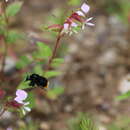en
names in breadcrumbs


Bombus brachycephalus is a species of bumblebee native to Mexico and Central America. This bee occurs in mountain and highland regions, where it lives in various types of forests. It is active year-round in many areas.[1]
This is an endangered species. Conservationists estimate its current range to be about 27% of its historical range. Threats to the species include the degradation and loss of habitat to agriculture, cattle ranching, urbanization, and mining. It is impacted by the use of insecticides, the loss of the native flora in the region, drought, and invasive species such as the common eastern bumblebee (Bombus impatiens).[1]
Bombus brachycephalus is a species of bumblebee native to Mexico and Central America. This bee occurs in mountain and highland regions, where it lives in various types of forests. It is active year-round in many areas.
This is an endangered species. Conservationists estimate its current range to be about 27% of its historical range. Threats to the species include the degradation and loss of habitat to agriculture, cattle ranching, urbanization, and mining. It is impacted by the use of insecticides, the loss of the native flora in the region, drought, and invasive species such as the common eastern bumblebee (Bombus impatiens).
Bombus brachycephalus es una especie de abejorro, un himenóptero apócrito de la familia Apidae. Es una especie nativa de México y América central. Vive en regiones montañosas y varios tipos de bosques. Es activo todo el año en muchas partes.[2]
Bombus brachycephalus está incluido en la IUCN Redlist como una especie en peligro de extinción desde el año 2015. Se calcula que su distribución presente es 27% de la originaria. Las amenazas a esta especie incluyen degradación de hábitat, uso de plaguicidas y la introducción de especies como Bombus impatiens.[1]
Bombus brachycephalus fue descrito originalmente por el entomólogo austríaco Anton Handlirsch y publicado en Akademie der Wissenschaften in Wien, Sitzungsberichte, Mathematisch-naturwissenschaftliche Klasse, Abteilung 3(3): 209-250 en 1888.[3]
Bombus brachycephalus es una especie de abejorro, un himenóptero apócrito de la familia Apidae. Es una especie nativa de México y América central. Vive en regiones montañosas y varios tipos de bosques. Es activo todo el año en muchas partes.
Bombus brachycephalus est une espèce de bourdons vivant en Amérique centrale.
On le trouve au Mexique, au Guatemala, au Honduras et au Salvador. Il vit dans les forêts de pins et de chênes, ainsi que dans les forêts tropicales décidues et sempervirentes[2].
Bombus brachycephalus est une espèce de bourdons vivant en Amérique centrale.
Bombus brachycephalus is een vliesvleugelig insect uit de familie bijen en hommels (Apidae). De wetenschappelijke naam van de soort is voor het eerst geldig gepubliceerd in 1888 door Handlirsch.[1]
Bronnen, noten en/of referentiesBombus brachycephalus[2][3][4][5] är en biart som beskrevs av Anton Handlirsch 1888. Den ingår i släktet humlor, och familjen långtungebin.[6][7] Inga underarter finns listade.[6]
Arten har stor färgvariation: Generellt är den övervägande svart med gula eller rödaktiga hår på mellankroppen. En form i centrala Mexiko har emellertid honor som är nästan helt svarta med rödorange hår på de sista tre tergiterna (segmenten på bakkrppens ovansida; hanarna har 7, honorna 6). Hanarna av samma form har tergit 7 (sista bakkroppssegmentet) orangeröd, och gulaktig päls på mellankroppen. En annan sydmexikansk och centralamerikansk form har drottningar, och ofta även arbetare helsvarta; de arbetare som inte är helt svarta har sidorna på tergit 2, och ibland också hela tergit 5, täckta med gul päls. Generellt är hanarna ändå mer variabla; vissa är helt svarta utom sidorna på de sista två eller tre tergiterna, som är gula, andra är svarta med gul päls på mellankroppen, speciellt sidorna, och gula sidor på varje tergit. Drottningarna är 16 till 18 mm långa, arbetarna 14 mm, och hanarna 16 mm. Mellankroppen är mellan 5 och 7 mm bred.[8]
Arten har påträffats på blommande väster som sunnhampor och Dalea bland familjen ärtväxter samt Leonotis nepetifolia och salviaarter bland familjen kransblommiga växter.[9] Den är en höglandsart, som förekommer mellan 700 och 2 700 meters höjd.[8]
Utbredningsområdet omfattar El Salvador, Guatemala, Honduras samt Mexiko (delstaterna Chiapas, Guerrero, Jalisco, Michoacán de Ocampo, Morelos, Nayarit, Oaxaca, Puebla, San Luis Potosi och Veracruz).[10]
Bombus brachycephalus är en biart som beskrevs av Anton Handlirsch 1888. Den ingår i släktet humlor, och familjen långtungebin. Inga underarter finns listade.
Bombus brachycephalus là một loài Hymenoptera trong họ Apidae. Loài này được Handlirsch mô tả khoa học năm 1888.[1]
Bombus brachycephalus là một loài Hymenoptera trong họ Apidae. Loài này được Handlirsch mô tả khoa học năm 1888.